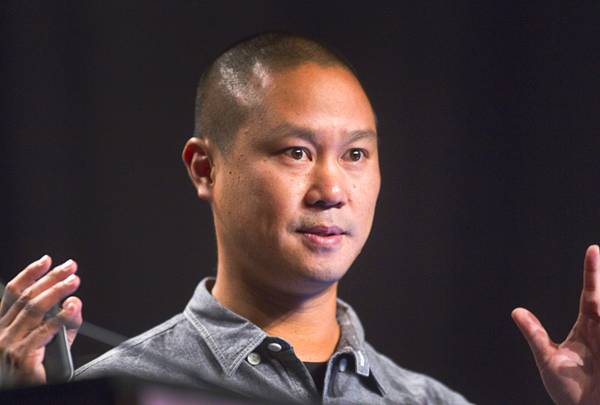Two years ago, Zappos CEO Tony Hsieh said he would have felt unsafe walking around the area where Container Park now sits on Fremont Street and 7th Street. Not only does Hsieh now feel safe, less than two years since the outside mall opened, he can boast bringing two million visitors to the area, crediting his $350 million investment in the downtown.
“It’s just been really cool seeing the evolution of this area,” said Hsieh, looking back after nearly four years since the investment, during a conversation with Frank Gruber, the CEO of Tech Cocktail, at Celebrate 2015, the organization’s annual conference.
Hsieh’s $350 million investment was initially split up across three different areas: real estate, an independent venture fund and a portfolio of small businesses — bars, restaurants and a bookstore. Tech Cocktail, a media and events organization, is part of the portfolio.
Hsieh’s goal of achieving a positive cash flow in all three areas by 2016 remains in place, despite setbacks. The Downtown Project has been criticized in recent years for failing to live up to ambitions to spur a turnaround of downtown — for focusing too much on bars and restaurants rather than residential housing, for the closure of several of its small businesses and for a number of its investments flopping. Hsieh said there was initially a lot of confusion about what the Downtown Project set out to do.
“The expectations that people have in terms of what community means, is, we’ve learned, very different when you’re talking about an actual neighborhood,” he said. “We had some people start expecting us to do certain things that maybe would be expectations for what the government should be doing.”
In the past year, Hsieh’s Downtown Project has kept a lower profile, while the CEO has made national headlines for implementing a new management structure at Zappos. Under the system, known as holacracy, employees are organized by roles rather than titles. After the reorganization was announced earlier this year, 210 employees, or about 14 percent of the company, took an offer to leave for at least three months’ severance.
Hsieh said at least half of those employees took the package for reasons other than holacracy. In other words: They were already planning to leave, but the offer “was just one of those things was too good to pass up.”
Though Zappos is expected to continue its experiment with holacracy, Hsieh also defended the Downtown Project’s decision to ditch the alternative management system. Zappos, he said, had the resources to solve aspects of business, such as compensation, that the management structure did not account for. The Downtown Project, as a smaller and newer organization that relied on more short-time workers like bartenders and waitstaff, did not.


Join the Discussion:
Check this out for a full explanation of our conversion to the LiveFyre commenting system and instructions on how to sign up for an account.
Full comments policy